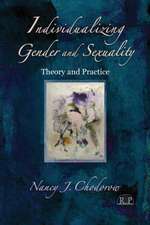Getting From Here to There: Analytic Love, Analytic Process: Relational Perspectives Book Series
Autor Sheldon Bachen Limba Engleză Hardback – 31 ian 2006
This holistic vision of treatment sustains a flexible clinical orientation that enables the analyst to "meet" states of consciousness in order to bring them into a system of which the analyst forms a part. Bach thoughtfully explores the clinical issues that enter into this taxing process, among them the establishment and maintenence of basic trust; the patient's or the therapist's presence in the other's mind; and the shifts in agency between patient and therapist. And he describes at length the frequently exhausting, even demoralizing, transference-countertransference struggles that enter into this type of analytic work.
Throughout, Bach is guided by the conviction that work with extremely challenging patients promotes the psychological growth and increased self-knowledge of patient and analyst alike. And he is admirably clear that the "mutual living through" of such treatments nurtures a kind of love between patient and analyst.
Getting From Here to There not only records the clinical lessons learned by an unusually gifted analyst; it also chronicles the movement of psychoanalysis itself from the dissection of love into component parts to a synthetic grasp of its vital role in psychoanalytically informed treatment.
Din seria Relational Perspectives Book Series
- 5%
 Preț: 288.36 lei
Preț: 288.36 lei - 5%
 Preț: 227.31 lei
Preț: 227.31 lei - 5%
 Preț: 248.39 lei
Preț: 248.39 lei - 5%
 Preț: 316.44 lei
Preț: 316.44 lei - 5%
 Preț: 309.04 lei
Preț: 309.04 lei -
 Preț: 266.64 lei
Preț: 266.64 lei -
 Preț: 229.70 lei
Preț: 229.70 lei - 5%
 Preț: 231.83 lei
Preț: 231.83 lei - 5%
 Preț: 267.45 lei
Preț: 267.45 lei - 5%
 Preț: 301.77 lei
Preț: 301.77 lei - 5%
 Preț: 273.23 lei
Preț: 273.23 lei - 5%
 Preț: 331.65 lei
Preț: 331.65 lei - 5%
 Preț: 189.76 lei
Preț: 189.76 lei -
 Preț: 273.84 lei
Preț: 273.84 lei - 5%
 Preț: 289.39 lei
Preț: 289.39 lei - 5%
 Preț: 231.83 lei
Preț: 231.83 lei - 5%
 Preț: 940.25 lei
Preț: 940.25 lei - 5%
 Preț: 232.77 lei
Preț: 232.77 lei - 5%
 Preț: 275.63 lei
Preț: 275.63 lei -
 Preț: 213.39 lei
Preț: 213.39 lei - 5%
 Preț: 274.21 lei
Preț: 274.21 lei - 5%
 Preț: 233.27 lei
Preț: 233.27 lei - 5%
 Preț: 315.51 lei
Preț: 315.51 lei - 5%
 Preț: 287.16 lei
Preț: 287.16 lei - 5%
 Preț: 219.18 lei
Preț: 219.18 lei -
 Preț: 371.53 lei
Preț: 371.53 lei - 5%
 Preț: 253.45 lei
Preț: 253.45 lei - 5%
 Preț: 183.34 lei
Preț: 183.34 lei - 5%
 Preț: 318.23 lei
Preț: 318.23 lei - 5%
 Preț: 266.90 lei
Preț: 266.90 lei - 5%
 Preț: 274.82 lei
Preț: 274.82 lei - 5%
 Preț: 346.04 lei
Preț: 346.04 lei - 5%
 Preț: 219.50 lei
Preț: 219.50 lei - 5%
 Preț: 231.91 lei
Preț: 231.91 lei - 5%
 Preț: 324.12 lei
Preț: 324.12 lei - 5%
 Preț: 401.89 lei
Preț: 401.89 lei - 5%
 Preț: 332.28 lei
Preț: 332.28 lei - 5%
 Preț: 534.99 lei
Preț: 534.99 lei - 5%
 Preț: 323.32 lei
Preț: 323.32 lei -
 Preț: 336.72 lei
Preț: 336.72 lei - 5%
 Preț: 416.67 lei
Preț: 416.67 lei - 5%
 Preț: 425.09 lei
Preț: 425.09 lei - 5%
 Preț: 456.44 lei
Preț: 456.44 lei - 5%
 Preț: 464.96 lei
Preț: 464.96 lei - 5%
 Preț: 382.83 lei
Preț: 382.83 lei
Preț: 1344.45 lei
Preț vechi: 1415.21 lei
-5% Nou
Puncte Express: 2017
Preț estimativ în valută:
257.29€ • 279.38$ • 216.12£
257.29€ • 279.38$ • 216.12£
Carte tipărită la comandă
Livrare economică 23 aprilie-07 mai
Preluare comenzi: 021 569.72.76
Specificații
ISBN-13: 9780881634396
ISBN-10: 0881634395
Pagini: 174
Dimensiuni: 152 x 229 x 17 mm
Greutate: 0.36 kg
Ediția:1
Editura: Taylor & Francis
Colecția Routledge
Seria Relational Perspectives Book Series
Locul publicării:Oxford, United Kingdom
ISBN-10: 0881634395
Pagini: 174
Dimensiuni: 152 x 229 x 17 mm
Greutate: 0.36 kg
Ediția:1
Editura: Taylor & Francis
Colecția Routledge
Seria Relational Perspectives Book Series
Locul publicării:Oxford, United Kingdom
Public țintă
ProfessionalCuprins
Preface. Introduction. On Being Forgotten and Forgetting Oneself. Narcissism Revisited. Working With the Challenging Patient. A Mind of One's Own. On Getting From Here to There. Confusion in the Analytic Hour. Sadomasochism in Clinical Practice and Everyday Life. Two Ways of Being. Psychoanalysis and Love.
Notă biografică
Sheldon Bach, Ph.D., is a Fellow of the Institute for Psychoanalytic Training and Research and of the International Psychoanalytical Association. Dr. Bach is Adjunct Clinical Professor of Psychology at the New York University Postdoctoral Program in Psychotherapy and Psychoanalysis and a faculty member and training analyst at the New York Freudian Society. The author of Narcissistic States and the Therapeutic Process (1985) and The Language of Perversion and the Language of Love (1994), he is in private practice in New York City.
Recenzii
"Like a sculptor who can see the form hidden within the block of stone, Sheldon Bach—most recently in his third book on narcissism…opens our eyes to the underlying structure and dynamics of narcissistic disorders. Bach’s observations and formulations are presented in an accessible, engaging and deceptively simple way, but they reflect precision of observation, clarity and sophistication of thought, deep empathy for patients, and genuine clinical wisdom. He is clearly gifted as a healer, scientist, and teacher." ---Jay Frankel, PhD
“Sheldon Bach lays bare the deep structure of psychoanalytic work, the process of developing awareness in the context of affective mutuality. His beautifully precise analysis provides an ecumenical and humane perspective on our psychic struggles and grants the essential analytic action of holding the other in mind its true significance. Presented with effortless lucidity, Getting From Here to There is a profound and practically useful integration of many strands in psychoanalytic history with contemporary understandings of attachment, regulation, and trauma.”
- Jessica Benjamin, Ph.D., New York University Postdoctoral Program in Psychoanalysis and Psychotherapy
“Bach explores the complexities, the ambiguities, and the importance of love in and out of the analytic situation. Getting From Here to There is full of clinical wisdom; more importantly, it uncovers the center of the analyst's emotional life.”
- Steven J. Ellman, Ph.D., President, Institute for Psychoanalytic Training and Research
"Reading Sheldon Bach's Getting From Here to There: Analytic Love, Analytic Process is an immersion into this master clinician and teacher's personal relationship with pscyhoanalysis. The gentle, rocking quality of his writing allows him to present new and far-reaching conceptualizations like a psychoanalytic lullaby, permitting the reader to relax and settle in, much as Bach's patients must. I recommend it to those in the first glow of love for psychoanalysis as well as to those who have loved it for a long, long time."
- Gemma M. Ainslie, in PsycCRITIQUES, Contemporary Psychology: APA Review of Books
“Sheldon Bach lays bare the deep structure of psychoanalytic work, the process of developing awareness in the context of affective mutuality. His beautifully precise analysis provides an ecumenical and humane perspective on our psychic struggles and grants the essential analytic action of holding the other in mind its true significance. Presented with effortless lucidity, Getting From Here to There is a profound and practically useful integration of many strands in psychoanalytic history with contemporary understandings of attachment, regulation, and trauma.”
- Jessica Benjamin, Ph.D., New York University Postdoctoral Program in Psychoanalysis and Psychotherapy
“Bach explores the complexities, the ambiguities, and the importance of love in and out of the analytic situation. Getting From Here to There is full of clinical wisdom; more importantly, it uncovers the center of the analyst's emotional life.”
- Steven J. Ellman, Ph.D., President, Institute for Psychoanalytic Training and Research
"Reading Sheldon Bach's Getting From Here to There: Analytic Love, Analytic Process is an immersion into this master clinician and teacher's personal relationship with pscyhoanalysis. The gentle, rocking quality of his writing allows him to present new and far-reaching conceptualizations like a psychoanalytic lullaby, permitting the reader to relax and settle in, much as Bach's patients must. I recommend it to those in the first glow of love for psychoanalysis as well as to those who have loved it for a long, long time."
- Gemma M. Ainslie, in PsycCRITIQUES, Contemporary Psychology: APA Review of Books
Descriere
It is clinical work with the most difficult patients-those with severe narcissistic, sadomasochistic, and borderline disorders-that poses the greatest challenge to the therapist's guiding assumptions about clinical process; indeed, such work often leads















